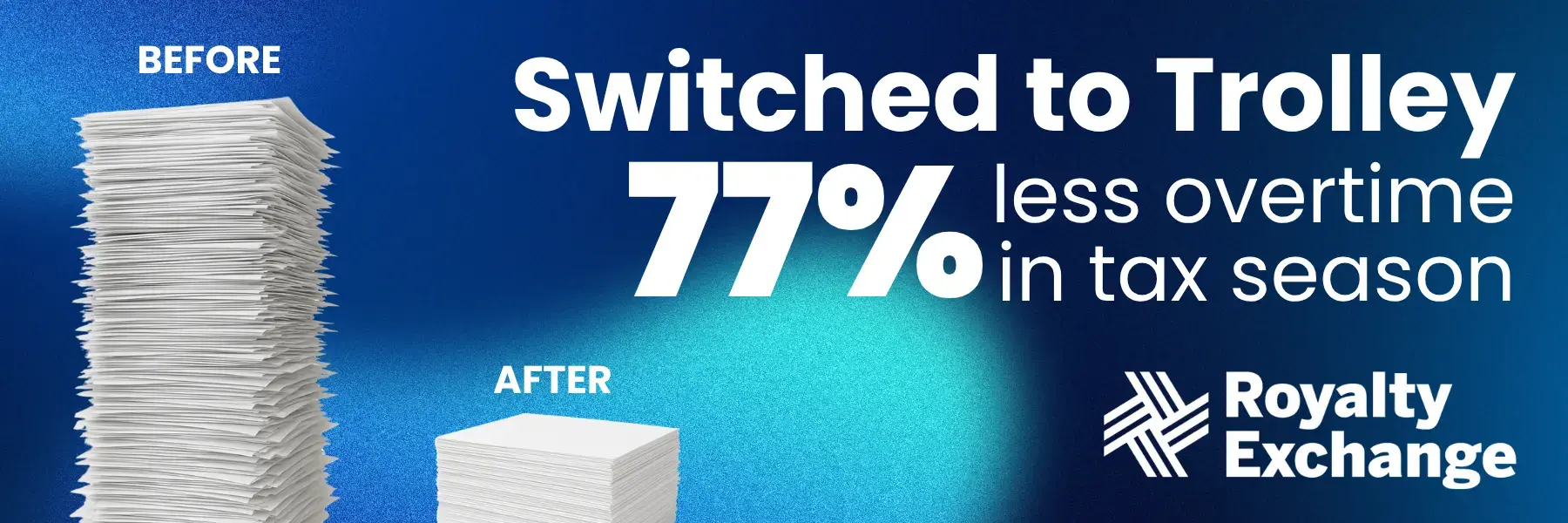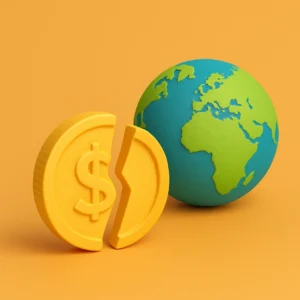Taxes. While we may not pine for the opportunity to wrap our heads around the intricacies of IRS tax compliance, it’s essential for music business professionals to understand how taxes on royalties are calculated and reported. In this guide, we break it all down so it’s easy to understand.
Royalties play a vital role in the success of music industry businesses. They enable companies and artists to receive ongoing compensation for their creative works long after the song or album is complete.
That doesn’t mean that understanding how they’re calculated and taxed is simple, though. The rise of streaming services and social media has changed the modern music landscape, making music more accessible and expanding the reach of artists all while simultaneously complicating royalty structures.
All that to say—yes, music royalties and the associated taxes can be tricky. But they’re important to understand, and this guide will attempt to explain everything step-by-step to help music business professionals make sense of it all.
We’ll dig into:
- Types of music royalties and how they differ
- How money from streaming and other avenues turns into royalties
- Royalties and taxes—the forms you need to know and how to file them
- Tips and best practices for staying compliant
Note: This guide focuses on how music royalties are calculated and distributed in the US. It covers tax implications and processes for companies paying royalties to US and international rights holders.

What we cover
What are music royalties?
At its core, a royalty is a payment made to the owner of a copyrighted composition whenever that work gets used commercially. Public performances, physical sales, digital downloads, synchronizations with visual media—nearly every use case carries an obligation to pay royalties. Rates vary hugely based on factors like use type, deal terms, and more.
Music royalties have always evolved alongside technological advancements. We dive into some of those advancements as we cover the different types of royalties that exist today, starting with print royalties.
Print royalties
Print royalties represent one of the oldest forms of music publishing revenue. Before the advent of recorded music, the best way to hear a song, outside of public performances, was to buy the sheet music and play it on the piano or guitar at home. Composers and publishers earned royalties from the sale of these scores—as they still do today, though print royalties have been eclipsed by other kinds of music revenues as people’s listening preferences have shifted.
Any time chord charts, lyric sheets, guitar tablature, scores, or folios containing compositions are legally printed and sold (this includes digital versions), royalty payments are generated to rights holders.
Mechanical royalties
The early 20th century brought about the rise of player pianos, which used perforated paper rolls to perform popular songs on their own. As the technology advanced to phonographs and vinyl records, the “mechanical reproduction” continued. The payment to the songwriters whose work was being reproduced came to be known as a mechanical royalty.
Mechanical royalties apply whenever a recorded composition is reproduced and distributed on physical products like CDs and vinyl records or digital formats like downloads, ringtones, and interactive streaming.
It’s important to note that mechanical royalties are not generated in streaming on non-interactive digital radio services like Pandora or SiriusXM—only on-demand streams where users pick songs generate mechanical royalties. Songs streaming on non-interactive platforms generate performance royalties only.
Mechanical rights organizations, most notably the Harry Fox Agency (HFA) in the US, handle the vital role of collecting mechanical royalties generated whenever a recorded track gets sold or streamed. They aggregate huge sales data streams, monitoring every CD, vinyl album, and digital download.
Performance royalties
Imagine hearing a song you wrote playing in the local cafe or blasting over the mall speakers. Maybe it comes on the car radio during your commute, or it streams on a popular playlist with millions of listeners. As the writer, you’d want cash for those public plays, right?
That’s where performance royalties come in. This money compensates rights holders when their tunes get played in public venues and media broadcasts. On the radio, at the ballpark event, pumped through restaurant speakers, or streaming online—anywhere there’s an audience listening, there could be a performance royalty payment headed your way.
As you can see, royalties in digital streaming platforms like SoundCloud, Apple Music, and Spotify have blurred the line in that they constitute mechanical and performance royalties. That’s because these streams are considered both public performances and mechanical reproductions.
Performing rights organizations (PROs) handle everything when it comes to collecting and distributing performance royalties. Groups like ASCAP, BMI, and SESAC issue blanket licenses to platforms and venues, allowing them to legally play songs from huge catalogs. They monitor where and how often tracks get used to collect money, then pay a share out to rights holders.
Synchronization royalties
Synchronization or “sync” royalties are generated any time an existing musical composition or sound recording is acquired to be paired or “synced” with visual media. This includes film and TV soundtracks, commercial advertisements, branded campaigns, video games featuring licensed songs, user-generated content, and more.
Rather than rely on statutory rates, sync deals involve direct negotiation between music rights holders and prospective media producers aiming to secure rights to feature music in their programming or campaigns. Synchronization royalty rates can fluctuate widely depending on factors like the prominence, timing, and duration of music use and the current popularity and legacy of chosen songs and artists.
How royalties are monitored and collected
Royalties wouldn’t exist without the behind-the-scenes work tracking how people use and pay for music. It takes an entire global industry to connect artists with income earned from their songs.
Companies monitor platforms to count plays and downloads. Based on deals and rules, they determine how much different record labels, publishers, songwriters, and performers should get paid. Then, the money splits up and moves where it needs to go.
It’s an endless cycle—usage happens, gets reported, calculated, and turned into payments. Hundreds of billions of micro-payments must find their proper homes across radio, streaming, YouTube, and more. The global nature of the music industry today means that artists have the opportunity for more reach than ever, but it also makes tracking and distributing royalties more complicated.
Royalties and the IRS: Taxation overview
Now that we’ve covered the basics of modern royalties, it’s time to dive into another complicated world—taxes! For music business professionals, understanding the tax implications of royalty payouts is just as vital as sending those payouts.
In this section, we’ll discuss how the IRS categorizes royalties and summarize the essential tax forms to provide to rights holders and file with the IRS.
Most songwriters and performing artists are treated as non-employees by music publishing companies. That means that, in the vast majority of cases, these rights holders do not receive Forms W-2 at the end of the year like a salaried employee would. Exceptions to this might include crew members or musicians who are paid a salary to perform.
For the most part, royalty and other music income will be reported on either Form 1099-MISC or Form 1099-NEC.
Form 1099-MISC: Miscellaneous Information
Form 1099-MISC is what’s known as an informational return, a tax form produced by businesses that have made payments to others. Any business that makes payments categorized as miscellaneous income to individuals or businesses must complete and file Forms 1099-MISC with the IRS and furnish a copy to payees.
For most types of income admissible under Form 1099-MISC, the minimum amount a single person or organization needs to have earned before the payor is required to produce and provide a 1099-MISC is $600.
There is one major exception to this de minimis threshold: royalties. The minimum amount of royalties paid in a tax year to trigger the production and filing of a 1099-MISC is just $10.
Form 1099-MISC is the go-to form for royalties earners—in other words, this form covers most cases in which someone needs to report royalty income.
However, in some circumstances, it’s Form 1099-NEC that should be used to report specific types of earnings from the creation of music.
Form 1099-NEC: Nonemployee Compensation
Form 1099-NEC is an informational return used to report a nonemployee’s gross earnings in a given tax year. Like the 1099-MISC, a 1099-NEC needs to be filed with the IRS and a copy must be furnished to the payee.
This form should be used when a contractor or freelancer earns $600 or more in applicable earnings. If royalties are classified as nonemployee compensation in a contractual agreement, they would be reported on Form 1099-NEC.
So, how do you know whether an artist should receive a 1099-MISC or a 1099-NEC?
In plain terms, if a company distributes royalties to an individual songwriter or an incorporated rights administration business, this would get reported on a 1099-MISC form.
However, if the company makes a payment for services rendered, like a studio musician working as a contractor or freelancer, this would get reported on a 1099-NEC instead. Likewise, if a musician is paid by a venue for a gig at a set rate, this would be reported on a 1099-NEC.
Form W-9: Request for Taxpayer Identification Number and Certification
To be able to accurately complete either Forms 1099-MISC or Forms 1099-NEC, you will need to request that your rights holders complete Form W-9. You won’t actually file these with the IRS, but they are necessary for collecting information about your payees.
The purpose of the W-9 form is to establish a person or a vendor’s identity and correct taxable status, and it requests information including their name, address, and taxpayer identification number (TIN).
Collecting a Form W-9 when an artist onboards or starts working for your company is a great way to ensure that you don’t end up chasing it down when tax season crunch time rolls around. Speaking of, when does all this need to be filed?
Filing deadlines
The filing deadlines for Forms 1099-MISC and Forms 1099-NEC are as follows:
- Payee statements must be furnished by January 31
- If paper filing with the IRS, the deadline is February 28
- If filing electronically with the IRS, the deadline is March 31
International rights holders
Foreign songwriters and artists face income tax withholding on royalty earnings depending on their country of residence and existing tax treaties. To avoid unnecessary withholding, it’s important to request that the rights holder in question fill out a Form W-8 BEN (the international equivalent of a W-9) and that you produce, furnish, and file a Form 1042-S (the international equivalent of a Form 1099).
Form W-8 BEN: Certificate of Foreign Status of Beneficial Owner for United States Tax Withholding and Reporting (Individuals)
All W-8 forms request a person or entity’s legal name, date of birth, address, U.S. tax information number (TIN), foreign tax information number (FTIN), nationality, and any tax treaty withholding exemption requests.
This information will be used to calculate withholdings on payments and produce a Form 1042-S at the end of a given tax year.
Unlike Forms W-9, Forms W-8 expire after three years. Being diligent about requesting new copies of this form before they expire is a vital part of maintaining a smooth tax compliance process.
Note 1: If you’re working with an entity (like a band) as opposed to an individual, the form you’ll need to ask them to fill out is Form W-8 BEN-E: Certificate of Foreign Status of Beneficial Owner for United States Tax Withholding and Reporting (Entities).
Form 1042-S: Foreign Person’s U.S. Source Income Subject to Withholding
Even though they are non-citizens, foreigners who earn income—including royalties—in the U.S. or from a U.S. company need to report and pay taxes on those payments.
The company or person making the payment is required to withhold an appropriate amount, based on the tax treaties in place.
If there is no tax treaty between the US and the country of residence, the general withholding tax rate is 30%.
If a tax treaty exists between the United States and the payee’s country of residence, the company making the payment can reduce the total withholding tax to the amount noted in the details of the tax treaty. Then, the payee manages taxes with their government instead of with the IRS.
This reporting is done via Form 1042-S, Foreign Person’s U.S. Source Income Subject to Withholding.
No matter their taxable status, Form 1042-S is an IRS form that individuals, corporations, and institutions in the United States must complete at the end of the year to record and report to the IRS the amounts they paid to—and withheld from—their non-citizen, nonresident workers.
Filing deadlines
Forms 1042-S must be filed with the IRS by March 15 of the year following the calendar year in which the income subject to reporting was paid, whether on paper or electronically. Unless March 15 falls on a Saturday, Sunday, or legal holiday, in which case the due date is the next business day.
Advance royalties
Paying advance royalties is a common practice in the music industry so that creatives can have their living expenses covered while they work on the music outlined in the contract. But how do those royalties get reported come tax season?
While these payments are royalty income, in that they represent payments made by the copyright holder to the artist, they are not treated as royalties for tax purposes. Advance royalties paid to cover expenses of songwriters, composers, recording artists, or other creatives should be reported as compensation for services on Form 1099-NEC rather than as royalties.
This is because, in most contracts, should the songs not end up making enough money for the record company to recoup their advances, the artist in question still gets to keep the advance royalties they were paid. So, the IRS treats this as payment for services rendered, not royalties.
Navigating royalty taxation: Tips and best practices
Making tax-compliant royalty payouts and streamlining end-of-year reporting doesn’t have to be overwhelming. Here are some best practices to keep in mind for music businesses:
Leverage technology
Automation solutions allow recording artists and songwriters to be satisfied faster with error-free distributions in local currencies and languages. Finance teams save countless hours previously devoted to customer service inquiries, status monitoring, and fixing inevitable misrouted wires. More music business productivity redirects towards creativity.
Here are some features to look for in a payout and tax automation platform for music businesses:
- Automating the collection of payment details and tax info directly from rights holders
- Allowing rights holders to view past payments and estimate future earnings
- Automating payouts on custom schedules
- Producing and distributing Forms 1099 and other tax documents tied directly to royalty payments
- Offering multiple integration options to connect with royalty accounting software
Centralize data
Maintaining clean, integrated systems makes it easier to map the connections across recordings, ownership percentages, songwriter details, and channels. Accurate attribution underpins proper royalty administration and tax compliance.
Maintain vigilant compliance
Financial penalties around inaccurate music royalty tax reporting or unpaid royalties can be severe, whether it be copyright infringement penalties, fines for underreporting to the IRS, or other legal issues. Ensuring diligent legal and accounting compliance across calculations, documentation, filing deadlines, and more remains imperative. Leave no room for errors, and prioritize transparency.
Royalty payouts with built-in tax compliance
Understanding music royalties and managing tax obligations is essential for businesses in today’s streaming and social media era.
But that’s not all of it—finding an automation solution to help streamline these processes is vital given how complex and time-consuming payouts and taxes are in the music space.
That’s where Trolley comes in. With payout and tax automation purpose-built for modern music companies, Trolley delivers your royalty distributions worldwide so you stay focused on bigger goals. With Trolley’s end-to-end platform plus ERP sync, you can keep your data centralized and connected. Onboard your artists, verify their identities, pay globally, and stay tax compliant, all in one place.
As artists onboard with Trolley, we collect all the info needed for Forms W-9 and W-8 BEN and automatically generate them and their corresponding Forms 1099 or 1042-S so they’re ready come EOY reporting time. Whether you use Trolley’s white-label portal, API, or embedded widget, it’s easy to collect payee bank and tax information securely.
And when tax season rolls around, e-filing with the IRS (or reporting for DAC7) takes just a few clicks.
Learn why companies like SoundCloud, Crucial Music, Soundrop, CD Baby, United Masters, and more trust Trolley to pay over 1.5 million musicians worldwide by getting in touch today.
This article is intended for educational and informational purposes only. Through the publication of this article, Trolley is not offering any legal, taxation, or business advice. We strongly encourage each reader to consult with their relevant lawyer, accountant, or business advisors with respect to the content of this post. Trolley assumes no liability for any actions taken based on the content of this or other articles.












